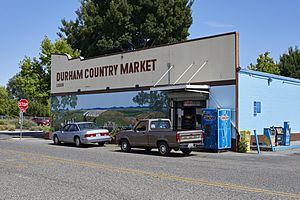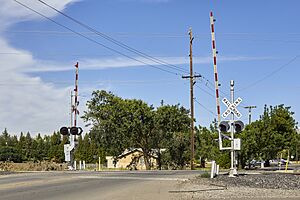Durham, California facts for kids
Quick facts for kids
Durham
|
|
|---|---|

Durham Country Market in June 2020
|
|

Location in Butte County and the State of California
|
|
| Country | |
| State | |
| County | Butte |
| Area | |
| • Total | 81.84 sq mi (211.96 km2) |
| • Land | 81.69 sq mi (211.57 km2) |
| • Water | 0.15 sq mi (0.39 km2) 0.19% |
| Elevation | 161 ft (49 m) |
| Population
(2020)
|
|
| • Total | 5,834 |
| • Density | 71.42/sq mi (27.58/km2) |
| Time zone | UTC-8 (PST) |
| • Summer (DST) | UTC-7 (PDT) |
| ZIP codes |
95938, 95958
|
| Area code(s) | 530 |
| FIPS code | 06-20270 |
| GNIS feature IDs | 0277502; 2408696 |
Durham is a small community in Butte County, California, United States. It is known as a census-designated place (CDP). This means it's a special area defined by the government for counting people. In 2020, about 5,834 people lived there.
Contents
Exploring Durham's Location
Durham is located in California. It covers an area of about 81.9 square miles (211.96 square kilometers). Most of this area is land, with a very small part being water.
What Grows in Durham?
The main crops grown in Durham are almonds and walnuts. These nuts are a big part of the local farming.
Durham's Weather
Durham has a Mediterranean climate. This means it has warm, dry summers and mild, wet winters. It's often called a "warm-summer Mediterranean climate" on weather maps.
A Look Back: Durham's History
Durham started as an experimental farming community. It was set up under a special California law in 1917.
The town was named after W. W. Durham, who was a member of the California State Assembly. The old Durham House still stands today. It reminds people of what the town was like long ago.
A railroad runs through Durham, and it has always been very important to the town. The railroad helped Durham grow and stay active. The Durham Flour Mill was also a key part of the community, even though it burned down several times.
In 2011, a small tornado hit the area south of Durham. It damaged many almond trees and some buildings.
Who Lives in Durham?
| Historical population | |||
|---|---|---|---|
| Census | Pop. | %± | |
| 2000 | 5,220 | — | |
| 2010 | 5,518 | 5.7% | |
| 2020 | 5,834 | 5.7% | |
| U.S. Decennial Census | |||
Durham's population has been growing steadily. In 2010, there were 5,518 people living there. By 2020, the population had grown to 5,834.
Population Details from 2010
In 2010, most of the people living in Durham were White. However, there were also people from many other backgrounds, including African American, Native American, Asian, and Pacific Islander residents. About 11% of the population identified as Hispanic or Latino.
The average age in Durham in 2010 was about 43 years old. Many families lived in Durham, with about one-third of households having children under 18.
See also
 In Spanish: Durham (California) para niños
In Spanish: Durham (California) para niños



